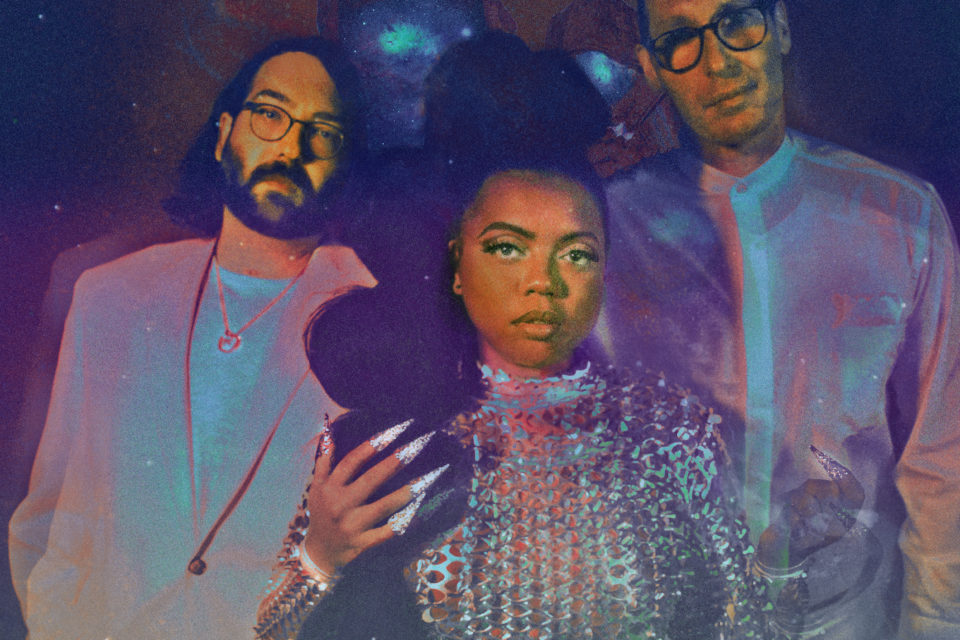It’s only fairly recently that disco has gotten its due as a musically and culturally significant pop art form. For decades, it was treated like a ‘70s novelty that paled in originality and staying power next to the work of the rock bards, but it’s clear now what a woefully incomplete and straight, white, dude-centric outlook that was.
A.J. Haynes, the visionary who leads the Shreveport band Seratones, has been unencumbered by that kind of thinking all along. First she got up to knowledgeable, proto-punk mischief on the group’s 2016 debut album Get Gone. “I was really big into a lot of Lucifarian imagery, you know, this idea of dancing around the devil,” she told me in an interview. “We think about the crossroads and we think about the origins of occultism in rock and roll. So much of it comes from the idea of the devil, of Lucifer, as trickster. I was very much so in my trickster mode, honestly, just trying to see what I could get away with.”
From there, she steered the Seratones toward the elasticity of soul on 2019’s Power. The band’s third album, Love & Algorhythms, is the first that could truly be called a soundscape, with its unbroken pulse and twinkly, enveloping textures. Haynes started writing for it after taking in a daily diet of disco innovators: “The spark would be ‘I Feel Love,’ the Donna Summer song. I was also listening to Sylvester, ‘I Need Somebody to Love Tonight.’ I know Donna Summer was known as the disco queen. But really, it was a trans, non-binary, femme Black artist named Sylvester who was the first disco queen. I was obsessively listening to them.”
The 11 tracks that Haynes ultimately shaped in the studio with band mates Travis Stewart and Jesse Gabriel and producer Paul Butler fall along an expansive continuum of danceable pop and R&B, futuristic in spirit but also grounded in lineage, from the lustrous, guitar-powered sound of disco to the automated thump of house and muscular, sleek and funky syncopation of new jack swing. It’s deeply considered, highly conceptual stuff that’s meant to be immersive, the drum machines and synthesizers serving as mechanistic engines for sensual experience.
During “Pleasure,” which distantly echoes Summers’ ‘70s sophistication, Haynes murmurs and teases, toying with dominance and submission: “Is it too much or enough for you, baby? Give me power and I won’t waste it.” Over a thicket of synthesizer triplets and surging guitar chords, she leaps up to attack the hook with zealous insistence: “I want you to live in pleasure.” “I’ll Be” pairs shrewd, jazzy vocal phrasing with the kinetic, synthetic snap and bounce of the beat, while Haynes’ singing on the pulsating title track seems to erase any contradiction between the robotic and the intimate, and her almost symphonic approach to vocal arranging on “Two of a Kind” takes her from exercising control to nearly abandoning it. The instrumental and programmed parts themselves add rhythmic tension and chaotic counterpoint.
The only moment that’s dramatically free of timekeeping of any kind is a poetic interlude called “Evidence” in the middle of the album. Haynes’ speaking voice doesn’t materialize all at once; it’s as if it’s being tuned in from somewhere else in the cosmos. “If the body is blameless,” she suggests a few lines in, ”then embrace me like a ribbon around a bomb.” Haynes is meditating on the body’s vulnerability to threats and harm, to getting swept up in music, to erotic possibility. She’s created the musical microcosm that she wants to live in, and invited us in.
The Seratones’ recently filmed a live session in the Sonic Cathedral.
Here’s what A.J. Haynes said about how the title Love & Algorhythms took on many dimensions over time:
Here’s Haynes’ take on the meandering path through concepts and collaboration that led to echoes of Donna Summer’s “I Feel Love” in the Seratones track “Pleasure:
And here’s the transcript of the above audio postcard:
Intro: Hey, it’s Jewly Hight, editorial director of WNXP, with a question for you, musically curious listeners: When you hear songs and sounds that seem to capture an alternate reality, doesn’t it make you wonder how that music came to be, what those behind it had in mind when they experimented with? Our Record of the Week, the Seratones’ new album Love & Algorhyhms, happens to be one of those otherworldly works. So I asked A.J. Haynes, the visionary who leads the trio, to colorfully and Insightfully recount, how she and her bandmates Travis Stewart and Jesse Gabriel and their producer Paul Butler, got here…
…After starting from much more muscled up, brutish, wily punk origins on the Seratone’s debut album.
A.J. Haynes: The original members of the band, we all put on DIY punk shows together, and I was very bored. So boredom led to wanting to see the world and what else is out there. That’s kind of the idea of Get Gone is like, “What can I do to reclaim space and see the world?”
We were in Paris playing the Bataclan for this festival that was part of a series re-opening the Bataclan after the mass shooting. And that moment was, for me, a very pivotal moment to say, “Oh, this is what’s possible. Here we are in this place where people were murdered. I can feel something here that needs healing. I have the possibility of being able to act as a doula, act as a healer.”
And so I shifted from writing just with the guys to doing a lot of co-writing, learning from other songwriters that I admired, writing by myself a lot, and that helped me develop healthier frameworks for how to create. I wanted to pay homage to the legacy of Black feminism that I wouldn’t be here if it weren’t for their voices, you know? And I just wanted to talk about what I was going through.
The spark would be “I Feel Love,” the Donna Summer song. I was trying to survive the pandemic, because whenever we wrapped up our last tour, I went straight into working full time at an abortion clinic, just witnessing all of the utter despair and also victories in those spaces. And my own safety, health, welfare, and just psychic well-being being in jeopardy. I would just blast “I Feel Love” on repeat. Really sitting between those two kind of worlds forged the ones that we’ve created with Love & Algorythms.
The title track is one of the first songs that I feel like I successfully demoed, like, all on my own. I arranged that and actually what we hear on the record is more or less how I arranged it in the demo. All of the vocal harmonic arrangements, I just did it. I didn’t even write them out. Even in the studio, I had to go back and listen to the demos and try to kick them out on the keyboard because I was like, “Who came up with this? This is crazy.”
I shared it with [Travis, Jesse and Paul] earlier so they could pick out parts and come up with some ideas. You know, I was reading a lot of Octavia Butler and specifically the Lilith’s Brood trilogy. And so I was just talking about aliens, really talking about how those aliens worked and how people adapted. But [there was] really lots of nonverbal communication. You know, I’ve known these guys for years. The main form of communication was the symbols that I created. Each song has a visual, a sigil, that represents the essence of that song. As we were in the studio, the sigils were posted around everywhere. And that’s what people would meditate on as they put down their parts.
Working on “Two of a Kind” was a real breakthrough. I remember specifically that being a time when I was just like, “This is the layout. Do whatever you want.” I don’t even remember the set up. We had an ARP Odyssey. We had the Juno O6, like, the classic Juno. We had the Prophet 12, and we were just running them all through each other. It was a crazy situation and it was just this immense feeling. I remember just looking over and seeing Paul bobbing his head like this and just being like, “Yeah,” and then Travis being over there tweaking stuff. So it just looked like four maniacs in a studio staring at each other and giggling. As everything was going on, and we were tracking and playing around with different stuff, I was like, “Yeah, this is it. This is the world that I want to be in.”

